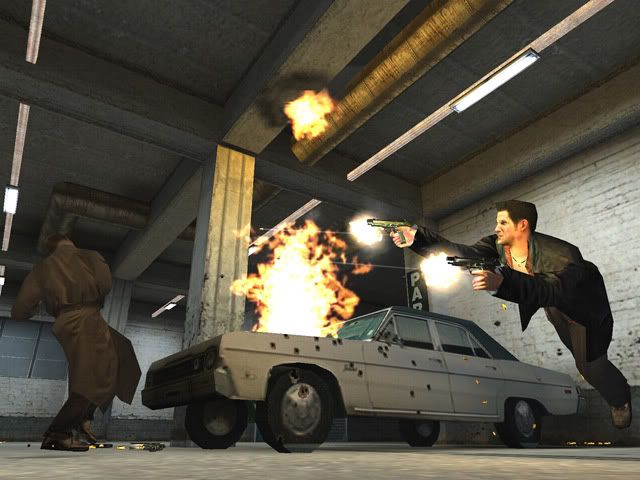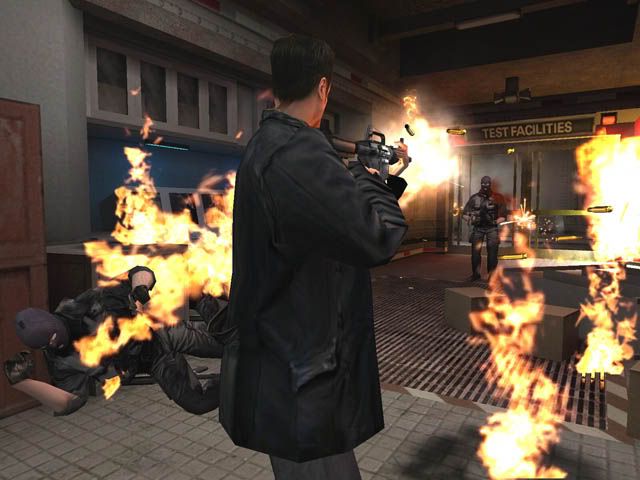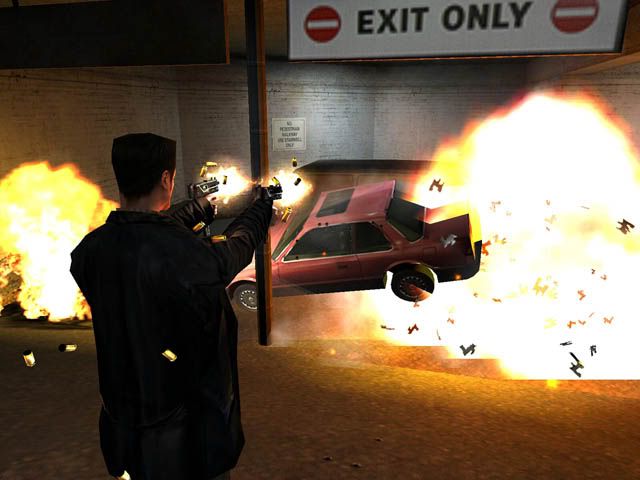
When Max Payne was released in 2001, it was critically acclaimed for its gunplay and its unique story presentation. The gunplay was largely inspired by John Woo films, and it introduced some game play ideas that have largely influenced other shooters that have been created since. With the impending release of Max Payne 3 for the current generation of consoles and PC, we are here to see how the original game holds up a decade later. Does the gunplay of Max Payne still remain fun, or has time not been kind to this classic?
Max Payne was once a simple New York cop living in a modest home with a loving wife and baby. One day, he comes home to find his family murdered and home ransacked by a couple of drug addicts that are high on the newest street drug Valkyr. Max decides to transfer into the DEA and goes undercover in order to uncover the source of the drug. However, years later in the investigation, Max is framed for the murder of a fellow DEA agent when the mafia learns that he is a cop.
The story of Max Payne is quite simply a story of revenge and redemption. Max is just a cop who has been pushed to the edge, and is looking to bring down those who have essentially taken his life away. Large portions of the tale are presented in a graphic novel style that is quite stylized and unique among shooters. Each ‘page’ of the novel is narrated by Max himself as he speaks with a largely melodramatic tone that emphasizes his feelings while not being too over the top. It keeps players engaged with Max and empathizes with his struggles. Some of the writing is borderline cheesy, but never overdoes it. There are a few neat twists and turns, some of which are predictable, but it services its purpose.

Back when Max Payne originally released, one of its notable features was a feature called bullet time. This mechanic slows time down to a crawl, but Max himself can still aim in real time. Using bullet time, players can overcome seemingly impossible odds and take down multiple enemies in style. Also thanks to how every bullet is physically modeled, gunshots could be visibly seen during bullet time, and as such possible to dodge. It’s simply a joy to run through a room taking out half a dozen thugs, and barely come out unscathed.
However, bullet time is not an over empowering ability. It is governed by a gauge that drains while it is active, and it only refills as Max kills his enemies. By regulating the use of bullet time, it keeps players from over abusing the mechanic. It also entices players to constantly kill while bullet time is active in order to keep his advantage going. With how many enemies that are trying to kill Max at any point in time, bullet time becomes something that is needed to survive rather than a gimmick that players only use occasionally. It is bothersome how little is regained from each kill given its near necessity to survive. During multiple playthroughs of the game, rarely did I have more than half a gauge available; barely a quarter most times. It was just enough to keep me alive, but for a game that strives for stylish kills, the lack of bullet time limits player creativity.
All of the foes that Max will face will challenge players and keep them on their toes. Unlike a typical stormtrooper, they are moderately accurate with their shots, and will certainly make Max feel pain. Their scripted behavior will make players keep on their toes as they will take cover behind objects and chase down max if they sense him retreating. However, their patterns become a bit predictable after getting through a third of the game; so it is possible to lead groups into a death march through a chokepoint without too much hassle.

For a game that is primarily about shooting, Max Payne’s selection in weaponry is pretty typical for the genre. There’s the usual assortment of pistols, shotguns, submachine guns, rifles, etc; some of which can be wielded akimbo. Each weapon fires with the accuracy and impact expected of each type. One especially cool feature is how the camera will travel behind bullets fired from the sniper rifle on its way to its target. It adds to the cinematic style of the game, and makes headshots feel so satisfying to nail.
The environments that Max travels through are just varied enough to keep them from looking too homogenized. Running through a love hotel, a rundown building that was just bombed, or an underground bunker never feels too much like running through the same level again and again. Each area has distinct layouts and interactive objects that set each one apart. The amount of details put into the environments really show how much care was put into developing the world.
Taking it a step further, the amount of interactivity with the environment is somewhat impressive for a game from 2001. Some is just aesthetics like flushing toilets and turning a sink on/off, while others are for gameplay purposes like firing on explosive propane tanks and hiding ammo and health refilling painkillers in cabinets. Occasionally when there is something nearby that is notable, Max will actually comment about what he sees and look toward it. If the player chooses to interact with it, the game shifts into novel mode where it expands on what it is and relates it to the story. These sorts of objects occur somewhat frequently, and the shift to a very brief graphic novel scene back to gameplay really kills the flow of the game.
Along with the environments, the spoken dialogue in the game also adds a layer of depth to the world of Max Payne. The Italian mobsters speak with a believable, if not a bit over the top, accent and use stereotypical phrases that sell the type of characters they are. Even more impressive is some of the hidden dialogue between enemies if Max gets close enough without alerting them. They banter on with each other like real people would, commenting on the current situation or something random. Hearing one mobster tell his buddy about how he named his gun “Dick Justice” is hilarious and memorable.

Unfortunately, the game stumbles when it goes into these dream-like sequences at specific points. These moments try to show players the guilt and torment that is going through Max’s mind, and to that effect it works. However, actually playing through these sequences is not very enjoyable. It mostly involves running through either a maze of hallways that look completely the same, or a dark area with only trails of blood that can be walked on. It becomes far too easy to get lost, and in the dark areas it is far too easy to fall off the trail resulting in death. These segments just seem to drag on for too long, and the maze-like layout does nothing but irritate the player.
While Max Payne originally released on PCs, months later it was ported to the Xbox and PS2. I have not played the PS2 version, but I have played through the Xbox version. For the most part, it is a faithful port. There are a few minor changes, some more notable than others. The most significant difference is how the Xbox version is quite a bit easier than the PC version on the default difficulty. Painkillers are given out like candy, each kill restores a bit more bullet time, and the aim assistance is a bit more generous. On top of that, it seems the dynamic difficulty adjustment in the PC version scales up much quicker. It becomes rather jarring when Max clears out an area, then in the next encounter a full shotgun blast into a thug’s chest at point blank range does not even phase him, let alone kill. For better or worse, it feels like the PC version is the one to play for a challenge, and the Xbox version for stylishly clearing rooms.
Beyond finishing Max’s tale of revenge, the extras to indulge in are very sparse. There are higher difficulties for those who want more of a challenge, with the highest difficulty Dead on Arrival being especially brutal if only for the fact that it only allows seven saves per chapter. There is also a special mode called New York Minute that is a forced speed run of the game. Players only get one minute to clear each chapter, but earn extra time with each kill. It emphasizes the frenetic pace of the gunplay which is great, but it also more prominently displays some of the issues with bullet time as it is implemented.
So going back to the original question, is Max Payne still fun a decade later? It most certainly is. It still presents itself with a unique style via graphic novel panels, and features an impressive amount of detail in its world. The gunplay is still tight as ever and challenging. It does have a few issues like some of the limitations of bullet time, the awful dream sequences, and inconsistent pacing due to the overuse of the novel presentation. Despite that, Max Payne is still worthwhile game to play, and it is recommended to any shooter fan.
|
+ Unique graphic novel presentation + Bullet time allows for memorable fights + Challenging, but fair |
|
- Psychedelic dream sequences tediously unfun - Graphic novel style used too frequently on minor explanations |
Final Grade: B-

No comments:
Post a Comment